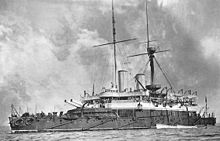
The British Royal Navy's ironclad Admiral-class battleships of the 1880s followed the pattern of the Devastation class in having the main armament on centreline mounts fore and aft of the superstructure. This pattern was followed by most following British designs until HMS Dreadnought in 1906. They were known as the Admiral class because they were all named after British admirals, such as Admiral George Anson.
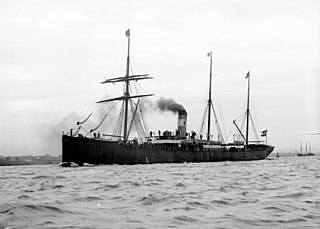
SSNorge was a transatlantic ocean liner that was launched in 1881 in Scotland, and lost in 1904 off Rockall with great loss of life. Her final voyage was from Copenhagen, Kristiania and Kristiansand, bound for New York, carrying passengers many of whom were emigrants. It was the biggest civilian maritime disaster in the Atlantic Ocean until the sinking of Titanic eight years later, and is still the largest loss of life from a Danish merchant ship.

SS City of Glasgow of 1850 was a single-screw passenger steamship of the Inman Line, which disappeared en route from Liverpool to Philadelphia in March 1854 with 480 passengers and crew. Based on ideas pioneered by Isambard Kingdom Brunel's SS Great Britain of 1845, City of Glasgow established that Atlantic steamships could be operated profitably without government subsidy. After a refit in 1852, she was also the first Atlantic steamship to carry steerage passengers, representing a significant improvement in the conditions experienced by immigrants. In March 1854 City of Glasgow vanished at sea with no known survivors.

HMS Anson was the last of six Admiral-class ironclad battleships built for the Royal Navy during the 1880s. The ship was completed, except for her armament, in 1887, but had to wait two years for her guns to be installed. She was assigned to the Channel Fleet in mid-1889 as a flagship for the fleet's second-in-command. Two years later, the passenger ship SS Utopia sank with the loss of 562 lives after colliding with Anson in the Bay of Gibraltar. In mid-1893, Anson was transferred to the Mediterranean Fleet, subsequently returning home in 1900 when she was assigned to the Reserve Fleet. She recommissioned for the Home Fleet in early 1901. Anson was paid off three years later and then sold for scrap in 1909.

HMS Anson was a ship of the Royal Navy, launched at Plymouth on 4 September 1781. Originally a 64-gun third rate ship of the line, she fought at the Battle of the Saintes.

SS Abyssinia was a British mail liner built in 1870, and originally operated by the Cunard Line on the Liverpool–New York route. She later served the Guion Line on the same route and the Canadian Pacific Line in the Pacific. In December 1891, Abyssinia was destroyed mid-Atlantic without loss of life by a fire that started in her cargo of cotton, further highlighting the danger in carrying both cotton and passengers on the same ship.
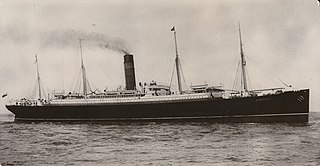
RMS Carpathia was a Cunard Line transatlantic passenger steamship built by Swan Hunter & Wigham Richardson in their shipyard in Wallsend, England.

Cato was launched at Stockton in 1800 and registered in London to Reeve & Green. She was wrecked on the Great Barrier Reef, Australia, in 1803 at.

SS California was a twin-screw steamer that D. and W. Henderson and Company of Glasgow built for the Anchor Line in 1907 as a replacement for the aging ocean liner Astoria, which had been in continuous service since 1884. She worked the Glasgow to New York transatlantic route and was sunk by the German submarine SM U-85 on 7 February 1917.

Marlborough was an iron-built two-decked merchant sailing ship which disappeared in 1890. She was built by the firm of Robert Duncan and Co., Port Glasgow and launched in 1876 for her owner John Leslie, who later sold her to the Albion Line. Marlborough disappeared during a voyage in January 1890, and has not been seen or heard from in over a century. Searches and investigations have yielded nothing conclusive, and the ship's ultimate fate, and that of her crew, remains unknown.

SS Kroonland was an ocean liner for International Mercantile Marine (IMM) from her launch in 1902 until she was scrapped in 1927. Kroonland was the sister ship of Finland and a near sister ship of Vaderland and Zeeland of the same company. Kroonland sailed for IMM's Red Star Line for 15 years, and also sailed for IMM's American Line and Panama Pacific Line. During World War I, the ship served as United States Army transport USAT Kroonland through April 1918, and as the Navy auxiliary USS Kroonland (ID-1541) from April 1918 to October 1919.

SS La Touraine was an ocean liner that sailed for the Compagnie Générale Transatlantique from the 1890s to the 1920s. Built in France in 1891, she was primarily employed in transatlantic service on the North Atlantic. The liner was scrapped in Dunkirk in October 1923.

SS La Bretagne was an ocean liner that sailed for the Compagnie Générale Transatlantique (CGT) from her launch in 1886 to 1912, sailing primarily in transatlantic service on the North Atlantic. Sold to Compagnie de Navigation Sud-Atlantique in 1912, she sailed for that company under her original name and, later, as SS Alesia on France–South America routes. The liner was sold for scrapping in the Netherlands in December 1923, but was lost while being towed.

The SSCity of Boston was a British iron-hulled single-screw passenger steamship of the Inman Line which disappeared in the North Atlantic Ocean en route from Halifax, Nova Scotia, to Liverpool in January 1870.

SS Delhi was a steamship of the Peninsular & Orient Line (P&O) that was lost off Cape Spartel, northern Morocco, at the entrance to the Strait of Gibraltar, on 12 December 1911. Among the passengers was Alexander Duff, 1st Duke of Fife, whose subsequent death in Egypt was ascribed to ill-health caused during the wreck, and his family, the Princess Royal and daughters Princesses Alexandra and Maud.
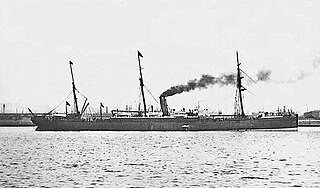
SS Catalonia was a cargo passenger vessel built in 1881 and owned by the Cunard Line.

Slavonia was a 10,606 GRT passenger ship that was built in 1902 as Yamuna for the British India Line. She was sold to the Cunard Line in 1903 and renamed Slavonia. She was wrecked in the Azores in 1909, but sent out the first SOS message. All on board were rescued.

SS Cheribon (1882-1902) was a transatlantic ocean liner steamship built for Compagnie Nationale de Navigation by William Denny & Brothers in Dumbarton, Scotland. Compagnie Nationale de Navigation initially employed the ship as a military troop transporter to French Indochina. Subsequently, the Cheribon was commissioned as a passenger ship for Italian immigrants, offering a New York route, as well as a South American route. She also was used at various times in her career as a cargo ship. The Cheribon was retired in 1899 and sold to Captain W. T. Pitt. In 1901, Pitt sold majority share of her to E. Gerrad, while retaining one-third ownership and command of the ship. On April 11, 1902, while carrying a shipment of coffee, the Cheribon wrecked on a reef off of Punta Remedios near Acajutla, El Salvador. All crew were eventually saved, however, the ship eventually sank.

USS Black Arrow (ID-1534) was a troop transport commissioned in 1919 to assist in the post-World War I repatriation of U.S. troops from France. Black Arrow was originally SS Rhaetia, a passenger-cargo ship built in Germany in 1904–05 for the Hamburg-America Line. From 1905 to 1914, Rhaetia operated primarily between Hamburg, Germany and South America, though she was also intermittently employed as an immigrant ship to the United States. With the outbreak of World War I in August 1914, Rhaetia was interned in Philadelphia.
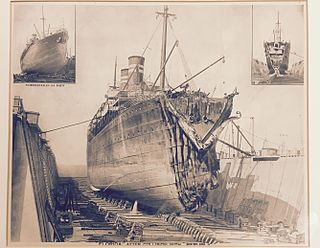
SS Florida was an Italian ocean liner, built in 1905 for Lloyd Italiano, which operated between Italy and both North and South America. In 1909 she collided with, and sank, White Star Line's Republic off the American coast. Later, as Cavour with Transatlantica Italiana, she was sunk by collision with the Italian auxiliary cruiser Caprera off the Spanish Mediterranean coast on 12 December 1917, without loss of life.

